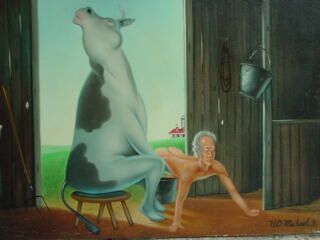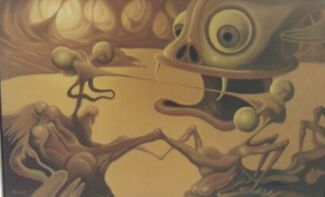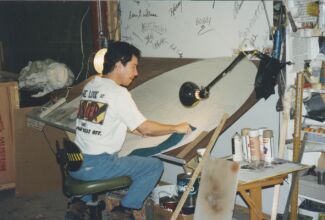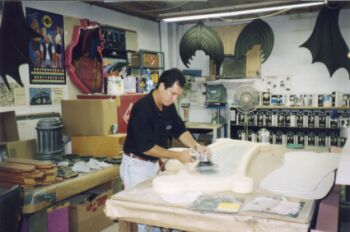|
www.harrydmichael.com |
Magazine Articles |
|||||||||||||||||||||||||||
April 14, 2002 Gainesville Sun Article, Click Here BEHIND THE BARN
Although he has had no formal training in art, many of the paintings
Michael does for himself reflect the influences of various art forms, particularly
early 20th century surrealism and Dadaism. His "Moaning Lisa"
is reminiscent of the artistic nihilism of Marcel Duchamp's "Mona Lisa's
Mustache". "Moaning Lisa" is the artist's image of an alien being's
conception of beauty. Michael says "we could be as ugly to them as
this is to us". The colors are muted, and like many of
his other paintings, blues and grays predominate. The
painting is overpowering, yet there is a delicacy in the strange
sharply edged face. It's distortion and dreamlike qualities suggest
surrealism. Harry Michael's "Statue of Liberty" is a political satire
on the rising tides of inflation and the economic and social infliction
it has recently placed on New York City. Two of his paintings,
"Eternity Spin" and "Clog in the Artery" Michael was born and reared on the island of Aruba, about 20 miles north of Venezuela. He spent twelve years there before his parents moved to Gainesville. Michael wants to return to Aruba to live and hopes to do this within the next two to three years, provided he can live comfortably from the proceeds of the Manimals series. He wants to have enough money to help other artists who have the talent, ability and drive but just aren't making it. Making it in art is difficult, even for someone like Michael who has an abundance of imagination and artistic skill. But he's been lucky recently, and the publicity from the Cedar Key incident hasn't hurt him a bit. In fact, those people who tried to censor his art may have done him a great service, and a few days ago Michael said "I just want to thank them." |
||||||||||||||||||||||||||||
| SIGN CHEF
by Eddie Wieber Sign Business Magazine, December 1997 "I never had to worry to about what I was going to do when I grew up". Harry Daniel Michael says. "I was too busy doing it". The security of knowing this has saved him the trouble of taking all of those side trips involved with a career search. Michael can trace his involvement with art and the sign business back to his grade school days, and before. "I didn't get into it in one day", Michael says, adding that it was an evolutionary process that he seemed to always be involved with. In fact, he doesn't even remember when he started drawing. He does remember when he first learned his woodworking skills. That was in grade school and because he had to stay late to sand and refinish desktops he'd drawn pictures on. Michael's paying job was a Nativity scene that he painted for a neighbor while growing up in his native Aruba, an island in the Caribbean off the coast of Venezuela. The job took three days and earned him 65 guilders. He was ten years old. "It was a lot of money for a kid in 1963'. he says. Over the years, his work has covered the art gamut. He is known for his ability to paint with oils on canvas in front of crowds, which he did while touring with the California Professional Artists Society during the early seventies. In 1983, to the beat of rock and roll, he painted a 100 foot wall mural of rock legends for a Florida nightclub. He's also produced a print series of fantasy aircraft titled "Flights of Fantasy", and of animals in reverse human situations, "Manimals". Currently, Michael is the Graphics Department Supervisor at Scenic Productions, Inc., Gainesville Florida. Scenic Productions is an international company that specializes in themed environments. BLUE SKIES AND GLITTER Michael says his "painterly abilities" are self taught. "I never apprenticed myself to a mentor, but I have worked with a tremendous number of people over the years, craftsman of all sorts". Aside from natural talent and ability, Michael is always on the lookout for fresh ideas ("I read Sign Business religiously", he says). While on tour, he was exposed to a group of artists who influenced him for years. Among them was Ed Kadegis. "Ed was the guy I learned how to do sunsets and clouds from, just by sitting there watching him", recalls Michael. His palette is always growing. "I listen well. I learn very quickly by watching somebody. I'm not afraid to try adding or throwing something else in the mix". This helps in producing some of the unusual projects that come through the door of Scenic productions. For instance, a recent project involved painting a five foot sculpted Nautilus shell. Michael did some experimenting with faux marbling and aqua colored glitter. He found that he could get a metallic foil-looking effect with the glitter that filled the cracks and recesses. "I'd never done that before, but I knew the effect that I wanted", he says. "It is like you're a chef in the kitchen and this is all we've got to eat today, so make a picture perfect gourmet salad". DAY TO DAY Michael says he feels lucky because the kind of work that comes to
him via Scenic Productions allows him to build the kind of signs that are
different, unique and innovative. "I don't think I would be doing
signs if it had to be just simple two dimensional cutout letters and such"
he says. He works closely with an outside group of vendors,
among who is John Newsome, the owner of Signs Galore, also in Gainesville.
"There are certain things we can't do at our shop. I know that when
I need it right away, I can go see John. He is my right arm". |
||||||||||||||||||||||||||||
| EVERYTHING IS TWISTED
By Eddie Wieber Sign Business Magazine, May 1999 Universal Studios Islands of Adventures opens this summer in Orlando. Seuss Landing, one of six islands in the park, is a trek into the bright colors and twisted world of Theodore Geisel's Dr. Seuss. Characters from the Cat in the Hat and other Seussian stories are alive here. And of course, Seussian signs, with twisted Seussian lines, fill up the Seussian rhymes, on the signs. They point to the rides and they point to the treats and tell little stories of critters. Like sneeches. It is serious sign making and the result is, as the world will soon know, one great big laugh. But that was the intention. WHAT DO YOU KNOW ABOUT THIS? "Things are very hectic at the shop right now, attending to every minute sculpt, hardcoat, FRP and paint detail", wrote Harry Michael back in November. "Somewhere in all of this confusion I've got to find time to sit down and hand letter like a four year old kid with a thirty dollar paint brush. I've actually had to unlearn everything I ever knew about lettering just to follow Universal's art director's wishes". And what were those wishes?
"Its amazing when you just glance at these things", says Michael. 'You don't think much about it, but they are almost indestructible". SIGN FACTORY, SEUSS STYLE
THE LAST WORD All of the paint used on the project is automotive quality. The colors were custom mixed to exactly match Universal's specifications through experienced eyes "Fluorescent yellows and greens are not available in normal auto painting", says Michael. "They're extreme colors that require the purest pigment. It isn't done with a computer. It is done with the human eye. It's like that with automotive colors". You can't just buy the Dr. Seuss letter style out of a book. The sizing and the colors are two things you just can't buy. It has to be hand done".
|
||||||||||||||||||||||||||||
| To Top | ||||||||||||||||||||||||||||
|
|
||||||||||||||||||||||||||||
 Last
month at a Cedar Key art festival, a Gainesville artist, Harry
Michael, was arrested and his art display temporarily confiscated
by law officers. Many people expressed concern with what they
believed to be the censorship of artistic freedom of expression.
But to others, the censoring of Michael's art was justified on the
grounds that the festival organizers had a right to remove that they considered
objectionable in order to maintain a family oriented show.
The work of art that was censored is by now a household word with Gainesville
artists. "Behind the Barn" is one in an upcoming series of 16 copyrighted
prints entitled "Manimals". These prints portray a reversal of roles
between man and beast. In "Behind the Barn", the artist's vivid
imagination is given a free rein. The imagery is bizarre. A
cow is "milking" a startled farmer. Another print, "Dinner
for Two", shows two pigs sitting at a table about to eat a man on
a plate with an apple in his mouth. After the initial shock wears
off, you decide whether you like the art or not. "People either
love it or hate it" Michael observes. But whatever your reaction,
you quickly see that his work is unconventional. Perhaps the genius
of "Manimals" lies in the artist's ability to satirize mankind's treatment
of the lowly animal. The humor emerges from the ridiculous position
man finds himself in when the roles of man and beast are reversed.
"Behind the Barn" particularly evokes a strong response from most people.
Michael believes it may be due to the mild eroticism of the painting. Michael
says " I didn't do it to offend people, obviously, because I haven't
shown anything. And he adds, "with all my Manimals, I want
to impress humor. I want people to get a good laugh and think".
Last
month at a Cedar Key art festival, a Gainesville artist, Harry
Michael, was arrested and his art display temporarily confiscated
by law officers. Many people expressed concern with what they
believed to be the censorship of artistic freedom of expression.
But to others, the censoring of Michael's art was justified on the
grounds that the festival organizers had a right to remove that they considered
objectionable in order to maintain a family oriented show.
The work of art that was censored is by now a household word with Gainesville
artists. "Behind the Barn" is one in an upcoming series of 16 copyrighted
prints entitled "Manimals". These prints portray a reversal of roles
between man and beast. In "Behind the Barn", the artist's vivid
imagination is given a free rein. The imagery is bizarre. A
cow is "milking" a startled farmer. Another print, "Dinner
for Two", shows two pigs sitting at a table about to eat a man on
a plate with an apple in his mouth. After the initial shock wears
off, you decide whether you like the art or not. "People either
love it or hate it" Michael observes. But whatever your reaction,
you quickly see that his work is unconventional. Perhaps the genius
of "Manimals" lies in the artist's ability to satirize mankind's treatment
of the lowly animal. The humor emerges from the ridiculous position
man finds himself in when the roles of man and beast are reversed.
"Behind the Barn" particularly evokes a strong response from most people.
Michael believes it may be due to the mild eroticism of the painting. Michael
says " I didn't do it to offend people, obviously, because I haven't
shown anything. And he adds, "with all my Manimals, I want
to impress humor. I want people to get a good laugh and think".
 show
definite similarities to the work of Max Ernst. Michael's use of
geometrically rounded parts of human and animal anatomy remind us of Earth's
curvilinear figure in Ernst's 1942 painting "Surrealism and Painting",
which shows a large beast, smoothly rounded, meticulously doing an
abstract painting.
show
definite similarities to the work of Max Ernst. Michael's use of
geometrically rounded parts of human and animal anatomy remind us of Earth's
curvilinear figure in Ernst's 1942 painting "Surrealism and Painting",
which shows a large beast, smoothly rounded, meticulously doing an
abstract painting.
 Michael
is a hands-on sign maker. While at Scenic Productions, he is
usually in the shop painting, building a sign, or else he is at a job site
installing a sign. Because of this, he's developed his own
philosophy of what's involved with sign work and the design process.
"Around here at the shop, every other week there is some new employee
straight out of art school trying to work; some of them don't want
to get their hands dirty painting. They think "graphics" is
sitting there at a desk creating images all day long. Well, that
is not all it is. You have to go one further", he says. "It
is interpreting what the client wants and supplying the finished product.
You have to know it will hold up outside. You have to know that it's
affordable. You have to know there is something different about it
that they just can't buy down the street. You just learn over the
years what not to do. I think that's extremely important".
Michael
is a hands-on sign maker. While at Scenic Productions, he is
usually in the shop painting, building a sign, or else he is at a job site
installing a sign. Because of this, he's developed his own
philosophy of what's involved with sign work and the design process.
"Around here at the shop, every other week there is some new employee
straight out of art school trying to work; some of them don't want
to get their hands dirty painting. They think "graphics" is
sitting there at a desk creating images all day long. Well, that
is not all it is. You have to go one further", he says. "It
is interpreting what the client wants and supplying the finished product.
You have to know it will hold up outside. You have to know that it's
affordable. You have to know there is something different about it
that they just can't buy down the street. You just learn over the
years what not to do. I think that's extremely important".  "There
isn't one straight line on this whole job", Michael says. "Everything
is twisted". A few weeks later, the office was beginning
to fill up with basically finished signs awaiting clearcoat and installation.
In all, there are 92 signs in the package. Each was handcrafted,
hand lettered, and built to withstand the grueling punishment dealt out
by Florida's sun, wind, and.....kids. "There is no getting around
the temptation for kids to put their hands on the signs, crawl over or
climb on top of them", Michael says. Everything has strength
right at the base so it won't snap off if some kid comes along and kicks
it. Everything here had to be made basically vandal proof.
When it's around kids, they tear everything up. (Do you get
the feeling he's been around some rowdy kids?)
"There
isn't one straight line on this whole job", Michael says. "Everything
is twisted". A few weeks later, the office was beginning
to fill up with basically finished signs awaiting clearcoat and installation.
In all, there are 92 signs in the package. Each was handcrafted,
hand lettered, and built to withstand the grueling punishment dealt out
by Florida's sun, wind, and.....kids. "There is no getting around
the temptation for kids to put their hands on the signs, crawl over or
climb on top of them", Michael says. Everything has strength
right at the base so it won't snap off if some kid comes along and kicks
it. Everything here had to be made basically vandal proof.
When it's around kids, they tear everything up. (Do you get
the feeling he's been around some rowdy kids?)
 Most
of the signs were built assembly line style. They were sculpted from
5 LB and 15 LB high density urethane (HDU). The inexpensive 5
LB material works well for general sculpting on poles and large shapes.
The more complex signs are sculpted from 15 LB HDU. After sculpting,
two coats of fiberglass reinforced plastic (FRP) hardcoat is applied at
a minimum of 3/16" thick. Where extra strength is needed, it
is applied 3/8" thick. The polyurethane hardcoat is made of
two plastics that are sprayed together. The coating cures quickly
and becomes a hard sheeting that seals in everything. After hard
coating, the pieces are sanded and a thick coating of automotive
primer is applied. They are then sanded with the same equipment as
would be used in an auto body shop. An air file, tiny
Dremels, pad sanders and a lot of hand sanding. Some get shafts
put inside that will accept a steel pole which is already set in concrete
on site. Others are prepared for installation using various hidden
attachments. Installation was planned to get in and out quickly.
"We just come along, slap a little glue on the bottom and pop them
down on the poles", Michael says.
Most
of the signs were built assembly line style. They were sculpted from
5 LB and 15 LB high density urethane (HDU). The inexpensive 5
LB material works well for general sculpting on poles and large shapes.
The more complex signs are sculpted from 15 LB HDU. After sculpting,
two coats of fiberglass reinforced plastic (FRP) hardcoat is applied at
a minimum of 3/16" thick. Where extra strength is needed, it
is applied 3/8" thick. The polyurethane hardcoat is made of
two plastics that are sprayed together. The coating cures quickly
and becomes a hard sheeting that seals in everything. After hard
coating, the pieces are sanded and a thick coating of automotive
primer is applied. They are then sanded with the same equipment as
would be used in an auto body shop. An air file, tiny
Dremels, pad sanders and a lot of hand sanding. Some get shafts
put inside that will accept a steel pole which is already set in concrete
on site. Others are prepared for installation using various hidden
attachments. Installation was planned to get in and out quickly.
"We just come along, slap a little glue on the bottom and pop them
down on the poles", Michael says.
 So
the fonts are made up, complete with curves, extra serifs and line weights.
The lettering is done with a special collection of brushes and a mahl stick.
"You get one chance", Michael says. "it's like a doctor's touch.
You have to real lightly curve and twist. It's a process of deep
breathing. You use the bottom of your stomach and make one long flowing
stripe in one try, and that's it. If you screw it up, good luck.
The trick is, don't screw up". A few of the more text intensive
operational signs were custom hand silk screened printed with the help
of John Newsome at Signs Galore in Gainesville. Automotive clearcoats
are the main protection again Florida's harsh UV light, and guarantee an
optimum level of performance. The signs can be washed and waxed like a
car too. MIchael says the project was a pure challenge for a graphics
supervisor. "It takes everything I know to do this. It includes
sculpting, auto body know-how, improvised hand lettering and
running a team to do it".
So
the fonts are made up, complete with curves, extra serifs and line weights.
The lettering is done with a special collection of brushes and a mahl stick.
"You get one chance", Michael says. "it's like a doctor's touch.
You have to real lightly curve and twist. It's a process of deep
breathing. You use the bottom of your stomach and make one long flowing
stripe in one try, and that's it. If you screw it up, good luck.
The trick is, don't screw up". A few of the more text intensive
operational signs were custom hand silk screened printed with the help
of John Newsome at Signs Galore in Gainesville. Automotive clearcoats
are the main protection again Florida's harsh UV light, and guarantee an
optimum level of performance. The signs can be washed and waxed like a
car too. MIchael says the project was a pure challenge for a graphics
supervisor. "It takes everything I know to do this. It includes
sculpting, auto body know-how, improvised hand lettering and
running a team to do it".